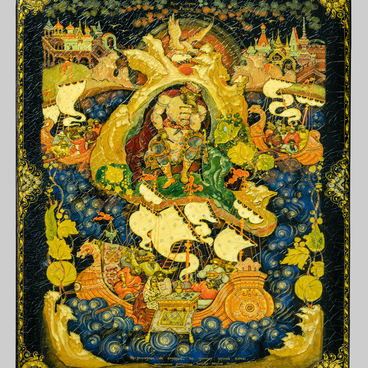The decorative panel Bova Korolevich (lit.: Bova the King’s Son) was created in 1976. Its author, Vyacheslav Morokin, is considered one of the leading Palekh artists of the late 20th and early 21st centuries. There are no random motifs in his works: he always avoided the literary plots that required simple illustrations.
The panel Bova Korolevich is based on the story of the same name. It falls under the category of Russian adventure fiction of the 17th century. The story tells about a hero who fled from home due to the machinations of his evil stepmother. During his wanderings, he fell in love with a beautiful girl and performed many feats for her. The pompous and flamboyant style of the literature of that time did not overshadow the character of Bova. Although the hero wasn’t without sin, he was always ready to protect the weak. It is important that even in the most difficult situations, he did not doubt the power of Divine providence. When someone tried to tempt him, he replied, ‘I would rather be hanged than abandon the Christian faith.’
Before creating the decorative panel, Vyacheslav Morokin thoroughly studied not only the legend about the hero but also perfect examples of the Palekh style: the famous icons Akathist to the Savior and The Life and Miracles of St. Nicholas, the Wonderworker, which are stored at the State Museum of Palekh Art. With the Bova Korolevich panel, the artist created an icon painting for the first time in many years. Bova himself resembles Saint George the Victorious. This approach shows that the artist had a holistic vision of the world: he demonstrated the deep connection between folk art and the Christian faith.
It should be noted that Bova Korolevich is not so much a literary character as a folk image: every country in Europe has legends about him. It is believed that the story is rather old. Its ancient roots, the presence in the legends of many different countries, and the protagonist’s unshakable faith in God once again emphasize the philosophical nature of Vyacheslav Morokin’s work. The artist did not just make an illustration for a famous fairy tale: this decorative panel reflects his personal view of the world.
The panel Bova Korolevich is based on the story of the same name. It falls under the category of Russian adventure fiction of the 17th century. The story tells about a hero who fled from home due to the machinations of his evil stepmother. During his wanderings, he fell in love with a beautiful girl and performed many feats for her. The pompous and flamboyant style of the literature of that time did not overshadow the character of Bova. Although the hero wasn’t without sin, he was always ready to protect the weak. It is important that even in the most difficult situations, he did not doubt the power of Divine providence. When someone tried to tempt him, he replied, ‘I would rather be hanged than abandon the Christian faith.’
Before creating the decorative panel, Vyacheslav Morokin thoroughly studied not only the legend about the hero but also perfect examples of the Palekh style: the famous icons Akathist to the Savior and The Life and Miracles of St. Nicholas, the Wonderworker, which are stored at the State Museum of Palekh Art. With the Bova Korolevich panel, the artist created an icon painting for the first time in many years. Bova himself resembles Saint George the Victorious. This approach shows that the artist had a holistic vision of the world: he demonstrated the deep connection between folk art and the Christian faith.
It should be noted that Bova Korolevich is not so much a literary character as a folk image: every country in Europe has legends about him. It is believed that the story is rather old. Its ancient roots, the presence in the legends of many different countries, and the protagonist’s unshakable faith in God once again emphasize the philosophical nature of Vyacheslav Morokin’s work. The artist did not just make an illustration for a famous fairy tale: this decorative panel reflects his personal view of the world.



